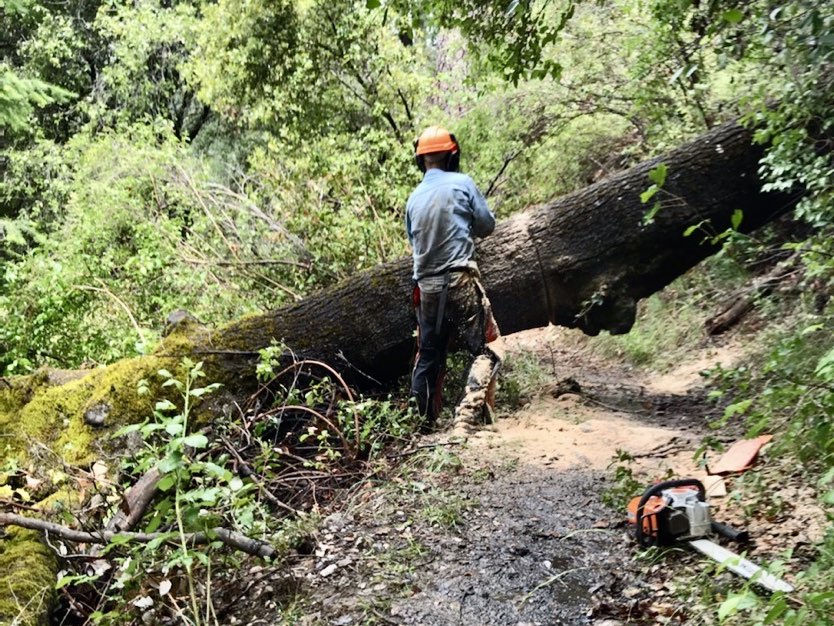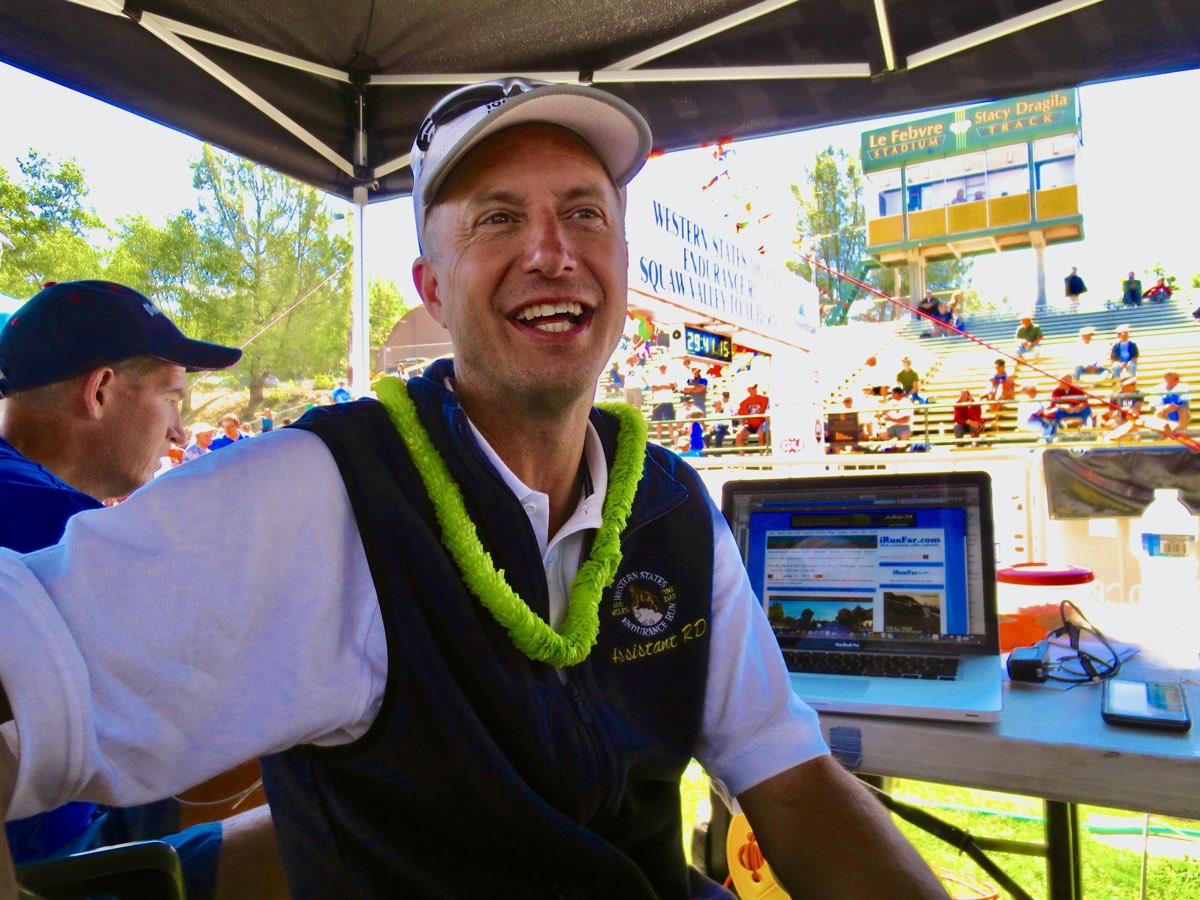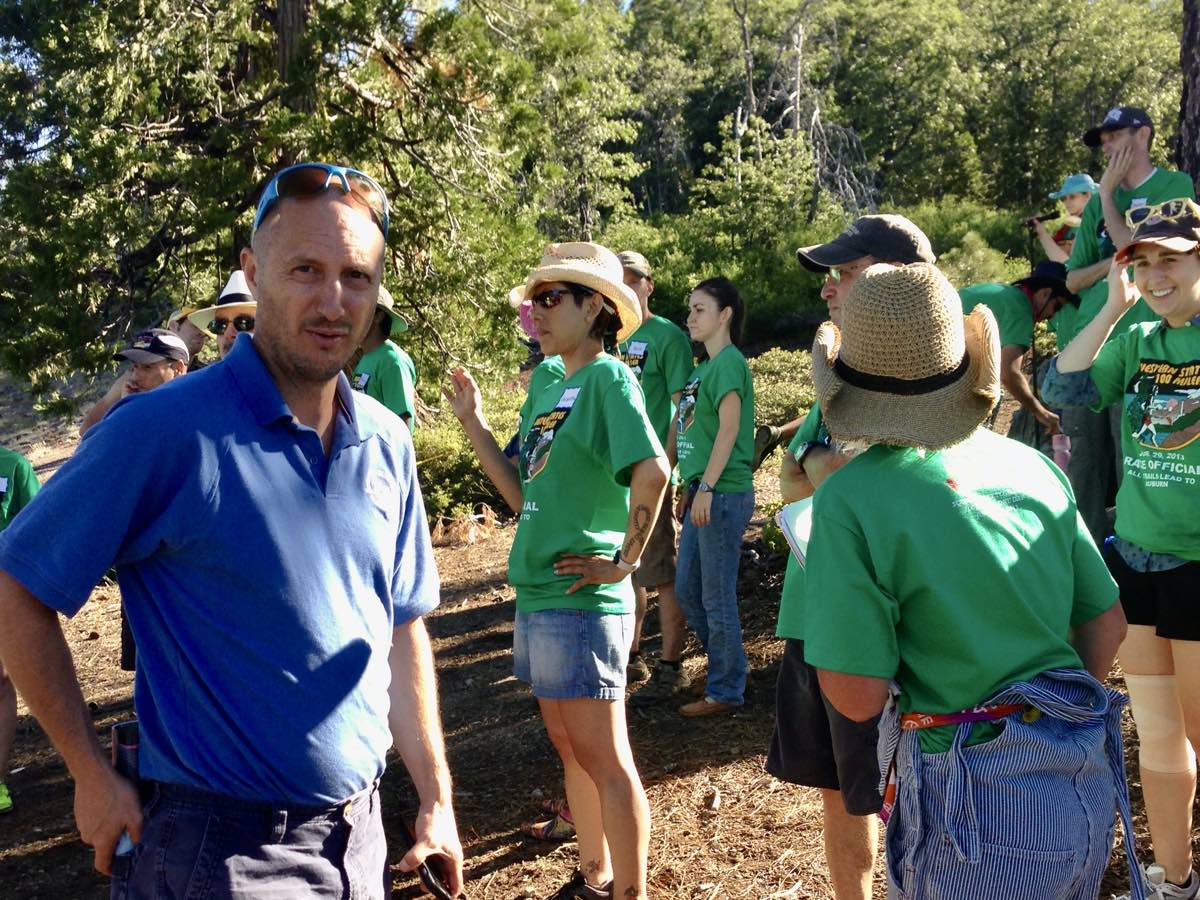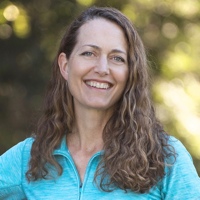Craig Thornley had just finished a yoga session at home when he sat on his deck in Auburn, California, for an interview via Zoom. Oak trees filled the background, and a little farther in the distance, the neighborhood gave way to a wild canyon that is like a second home to Thornley because he has spent so much time running along the iconic Western States Trail there.
Thanks to some combination of fate and smart planning, his home sits near mile 99.5 of the venerable Western States 100 (WS 100) course, the event that has shaped his life ever since he encountered wild-eyed runners passing by mid-race when he was an impressionable 14-year-old.
Ordinarily, with race day approaching, Thornley would be in overdrive performing his full-time job as the WS 100 race director. He manages an army of volunteers and works with a 15-member board of directors to ensure that every aspect of the race runs smoothly. All year long—culminating in the last weekend in June, from the moment 369 runners depart from Olympic Valley, California at 5 a.m. Saturday until the final runners cross the finish line in Auburn 30 hours later—Thornley personally manages the details of the event’s lottery, sponsorship, rules and policies, race-day communications, aid stations, trail maintenance, training camp, public relations, and each runner’s experience.
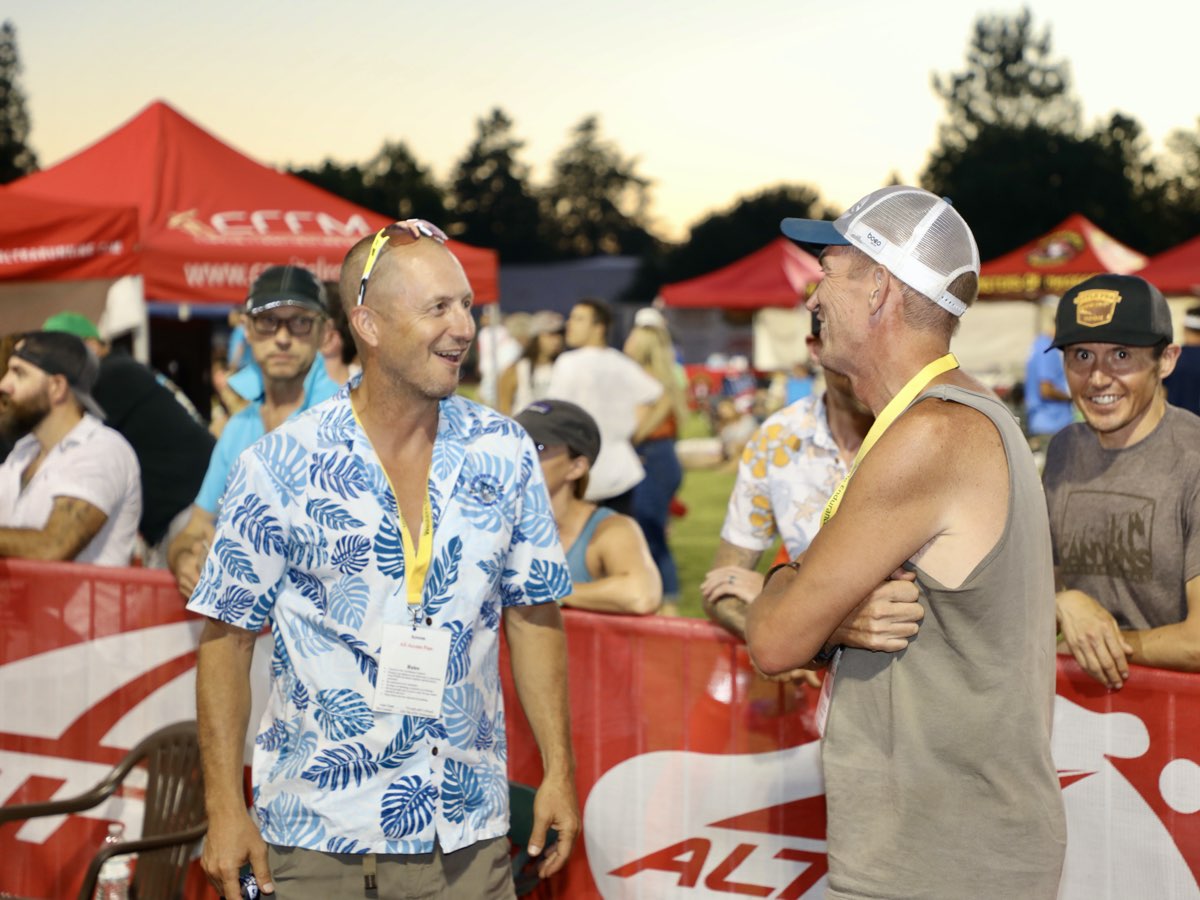
Craig Thornley, Western States 100 race director, with Andy Jones-Wilkins at the finish line in 2018. Photo: iRunFar
But this is no ordinary year. Thornley and the board decided in late March to cancel the Western States 100—the world’s oldest 100-mile footrace, started in 1974—due to the COVID-19 pandemic. It has only been canceled once before, in 2008 due to wildfires.
Thornley suddenly found his job drastically altered for the year. And in a double whammy of disappointment, he also saw his personal summertime goal race, the 300-kilometer PTL (part of the UTMB festival in Chamonix, France), canceled.
“I thought things would slow down” after he and the board canceled the race and its Memorial Weekend Training Runs, “but I’ve actually been busy. … It’s been crazy, really crazy” handling myriad issues that cropped up due to the pandemic and the event’s cancellation.
Plus, he’s been spending a fair amount of time on the Western States Trail clearing downed trees—but that’s a treat, not a chore. “Oh my god, I love trail work more than anything,” he said. “It’s so satisfying.”
The events’s March 27 announcement to cancel came after two fast-paced weeks during which the magnitude and repercussions of the pandemic became more dire each day. On March 10, Thornley and the board announced, “We do not anticipate canceling or postponing our event at this time,” and March 24, they issued a statement saying, “We continue to plan for our runners to assemble during the weekend of June 27-28, but … in the event that the coronavirus situation does not improve, we are also exploring the possibility of postponing the event…” Three days later, they pulled the plug.
Thornley explained his thinking back in March, when he resisted canceling until days before the final announcement: “I was looking at the situation as, ‘This is a challenge for us as an organization and for me as a race director that we have to overcome to put on the race.’ I had challenges in the past, like in 2011, at the Waldo 100k”—the event in Oregon that Thornley co-founded in 2002 and directed for 11 years—“we had a fire in the middle of the course on Wednesday night [before the weekend event], and we still put on the race with a new course. That’s what race directors do: We figure out how to solve problems and put on the race. I was still in fight mode.”
But his point of view took a 180 after he discussed the situation extensively with WS 100 Board President Diana Fitzpatrick, who was living under more restrictive shelter-in-place orders in the San Francisco Bay Area. He credits her with getting him to see how difficult it would be for runners to train under these restrictions, and how traveling from out of state or out of the country to participate posed risks.
“Once I stopped thinking about, What is it going to be like on June 27, to, What is it like for runners right now trying to prepare for Western States, and I considered the situation that runners found themselves in financially and with their families, it became obvious we had to cancel. This is big stuff, life and death, way bigger than putting on a race.”
How did the runners react? “For the most part, the runners, while sad, also were relieved.” Entrants will have their entries rolled over to 2021.
Now Thornley and the board are grappling with consequences of the pandemic, everything from how the cancellation of this year’s edition affects qualifying races, sponsors, and the entry process for 2021 and beyond; to how the race, its training camp, and all aspects of the event may need to be modified in a COVID-19 world. Thornley, a change agent, seems to take the challenges in stride.
Said Fitzpatrick about Thornley, “The job of the WS 100 race director has evolved under Craig into something that requires the type of multi-faceted skills he has. He manages everything from hundreds of volunteers to relationships with the city of Auburn, the Forest Service, and other permitting agencies, and much more. This is all while managing a fairly demanding on-hands board of 15. He’s able to do this so well because of his interpersonal skills and because he can stay on top of so many different things.”
Growing Up with the Western States Trail as His Back Yard
Thornley, 56, can genuinely empathize with Western States runners and understand how much the race means to them, because he’s participated in the event and bent nearly every year’s plans around it ever since he was a young adult. He felt the sting of not getting an entrant spot through the event’s lottery in 2003, and he experienced the deep disappointment of the event cancellation in 2008.
He knows what it feels like to finish in the top 10, placing 10th in 2005 at age 41 with a PR of 18:25. And he knows what it feels like to be a struggling back-of-the packer approaching the finish line during the event’s “Golden Hour,” clocking in at 29:11 in 2017 at age 53.
Thornley’s parents unexpectedly planted the seeds for his long-running relationship with the Western States 100 when he was 12 and they got divorced. His mother remarried, and his stepfather moved the family from the Bay Area to Cool, a rural hamlet six miles from Auburn, also near the Western States Trail, to live in the countryside.
“I was angry at the whole thing,” Thornley recalls. “He was not my dad, so at that age, I was like, ‘What are you doing in my life?’ But as I got into high school, I learned to appreciate what he could offer me.”
As a young teen in the late 1970s, Thornley was given a loose rein to explore the wilds, often with his little brother, Chris Thornley, at his side. “They let us do whatever we wanted in the canyons. Parents now probably wouldn’t let their kids do that,” he said.
The boys, then only 14 and 8, were camping by themselves one night in late June of 1978, the summer after Thornley’s eighth-grade year, down by American Canyon Creek near Auburn Lake Trails (where the mile 85 aid station is located). They slept next to the creek, right along the trail.
All of a sudden, a tired and dirty-looking runner passed by, cooled himself off in the creek, and asked, “Where’s the aid station?” Then another and another passed by asking the same thing. By talking to the runners, the boys ascertained that these men had run an unfathomable 80-some miles from Olympic Valley, and they would keep running all the way to Auburn.
“There weren’t that many runners [back then]. There were big gaps between them,” he said, laughing at the idea of camping in the middle of the race route. In 1978, the race had 63 starters and 30 finishers.
Speaking on behalf of his brother, Thornley said, “We both, as we recall it, remember seeing the look in the eyes of these runners, and knowing, ‘We want to experience whatever they have gone through to get to that point.’ It really stuck with us.”
Their mother further sparked the Thornley brothers’ interest in ultrarunning by connecting them to the volunteer squad at the mile 38 Dusty Corners Aid Station. She knew the longtime aid-station captains, Judy and Luke Rinehimer, and began volunteering there with her boys tagging along.
The aid-station crew introduced the brothers to the notion of “the Western States family,” the tight-knit community around the event, and sparked what Thornley describes as his “obsession” with Western States. “I wouldn’t see these people at any other time of the year, but each WS 100 race day we’d join together and pick up where we left off. … I remember laughing, joking, helping runners, and giving the runners the Dusty Corners shower—old-timers will remember those,” he wrote in a blog post.
Thornley and his brother volunteered at Dusty Corners for about 10 non-consecutive years, from the mid-1980s through the 1990s, and like apprentices learned the finer points of ultrarunning firsthand from runners.

The Western States 100 Dusty Corners Aid Station crew probably during the 1980s, with Craig at far left. Photo: Judy Rinehimer
Spending time around ultrarunners impressed upon Chris Thornley, too. Chris, like Craig, also would become an accomplished ultrarunner with a half-dozen 100-mile finishes. Chris made his mark on the sport by founding Squirrel’s Nut Butter, a company focused on athlete skin care.
Chris recalls, “Getting the opportunity year after year to witness people running 100 miles at such a young age made the journey almost seem normal. Volunteering at Dusty Corners allowed me to help, first-hand, the leaders as well as the very back of the pack. I remember helping some folks at Dusty who looked like they couldn’t walk another step out of the aid station, only to see them round the track the next day and earn their buckle. [I learned that] desire seemed to be the foundation of the runners headed to Auburn and you weren’t going to get very far without it.”
Some years, Craig Thornley would volunteer at the aid station and then jump into the race to pace. His first pacing gig came in 1985, when he was 21, and he ran the final 10 miles of the course with Bruce Von Borstel, who was 39 and placed ninth in 18:39. Thornley had started running seriously on the track team in high school, and Von Borstel, whose wife knew Craig’s mom, took Thornley under his wing.
“The race was awesome back then, no doubt! But, Bruce used to eat pork and beans out of little cans [while running the race], and I found that so bizarre. They didn’t know as much back then [about nutrition and hydration] compared to what we know now, but they were still getting it done.”
Finally, in 2001 at age 37, Thornley felt ready to attempt the Western States 100 himself. He had run one other 100 miler the prior year—the Arkansas Traveler 100 Mile, where he placed third in 18:35—so he entered Western States with aspirations to finish around 19 hours.
The Making of “Lord Balls”
Thornley’s Western States debut featured rookie drama, along with cans of pork and beans that he ate along the way, which he laughs about in hindsight.
“I was surprised how mentally unprepared I was,” he said about his first run at Western States. “I got to the climb up Devil’s Thumb [around mile 47], and I was dizzy and struggling and actually thought, I might have to drop out! Then I had blister problems, so I stopped at Foresthill [at mile 62] for nine minutes and thought that was devastating. But I was still on 20-hour pace!” He finished 16th overall in 20:20.
In the years that followed, “each year I learned a little more about training and got closer to top 10.”
Starting in 2004, Thornley and some of his ultrarunning buddies began renting a place in Michigan Bluff, midway along the Western States Trail, to train for a week on the course. Andy Jones-Wilkins, who met and became friends with Thornley at the finish line of the 2003 Angeles Crest 100 Mile, was among those who participated and recalls about Thornley, “He was intensely focused on training, and he’s an unapologetic track guy. His weekly track workouts were legendary. … Some of my fondest memories ever were on those training camps” at Michigan Bluff organized by Thornley.
Thornley’s training paid off in 2005, when he lowered his PR by 21 minutes and finished 10th at Western States in 18:25. That was the year he earned his “Lord Balls” nickname, which he uses as his social-media handle.
“The general perception is it’s got some perverse meaning,” Thornley said, “but it’s not that at all!”
He credits his stepfather’s elderly mother with bestowing the moniker. She was in a convalescent home in Auburn but, in 2005, managed to get out to watch Craig race.
“I was going through Foresthill and didn’t even see her there. Then I went to see her at her home after the race, and she was a feisty woman, and she says, ‘You ran by like you were Lord Balls or something!’ It means someone who thinks highly of themselves, like they’re too important, and it was just the perfect name for me. She died a couple of months after the race, so it seemed appropriate to keep it.”
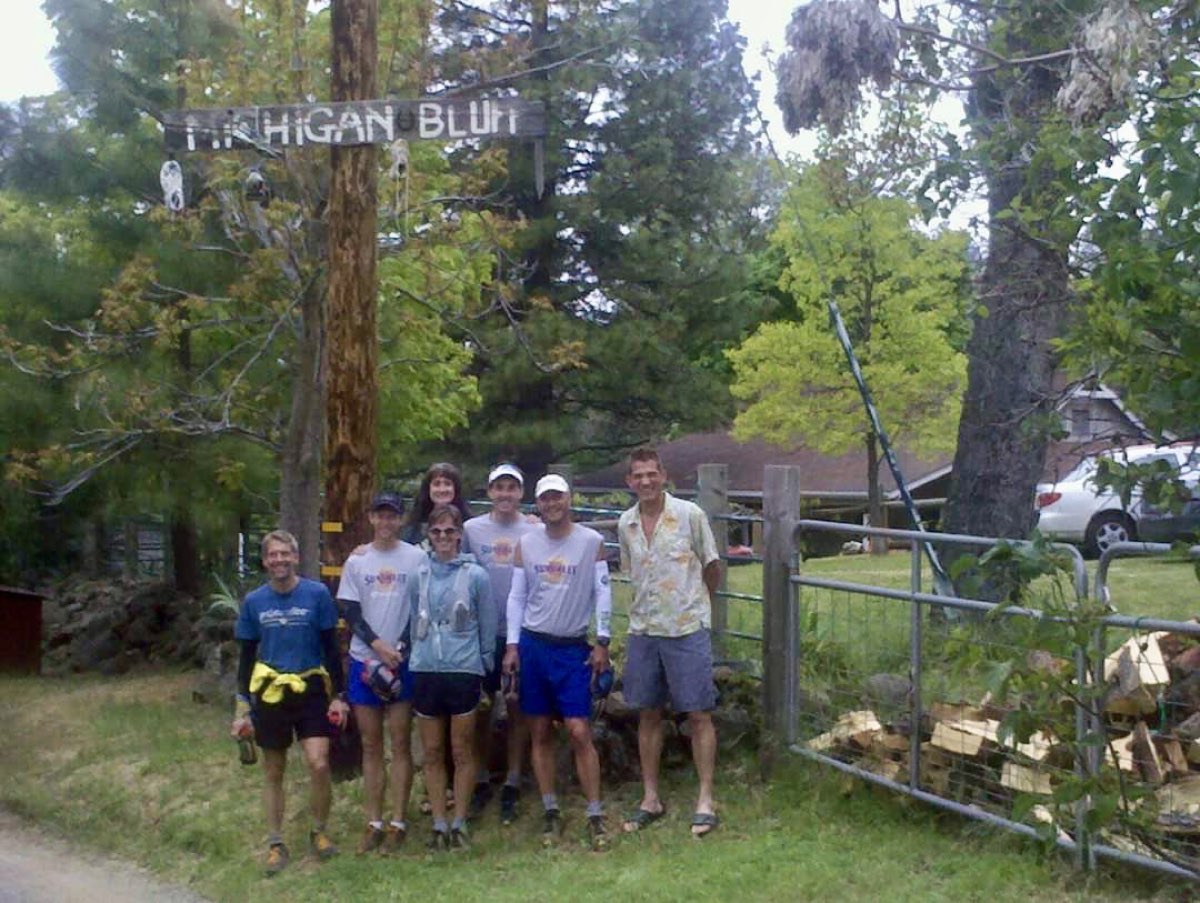
Craig, second from the right, training with friends in Michigan Bluff on the Western States Trail around 2011. Photo: Laurie Thornley
If 2005 was his best performance at Western States, 2007 and 2010 rank among his most difficult. The circumstances are worth describing as they illustrate an outdated practice that the Western States 100 did away with: the use of scales for weigh-ins.
Thornley’s starting weight in 2007 was 147. When he got to the mile 43 Last Chance Aid Station, he stepped on a scale as required, and it showed his weight down to 142. Figuring he was dehydrated, he chugged two 24-ounce bottles of water, downed a couple of salt pills, then at the next creek refilled his bottles and drank them too. At the next aid station, Devil’s Thumb, the scale showed his weight had shot up nine pounds to 151. His weight continued to fluctuate, and after mile 80, he started puking. He still managed to break 20 hours by about three minutes.
Three years later, Thornley again overhydrated and likely became hyponatremic. He felt so terrible, he stopped and rested along the trail around mile 90. “This is what I live for—my whole year of running is about this race—and I lost all desire to move forward.” He spent almost two hours on a cot at an aid station and then decided to walk all the way to the finish, finishing his humbling 2010 run in 22:17.
As the years passed, WS 100 medical staff and others realized that the weigh-ins prompted some runners to overhydrate and also to over-salt. The use of scales also unintentionally created adversarial tension between runners and the medical staff, since the medics at the weigh-ins had the authority to make runners rest or even drop based on their weight. The WS 100 stopped monitoring weight and began advising runners to drink to thirst and avoid excessive sodium supplementation.
“Dropping the scales and putting the responsibility back on the runners was a major shift in philosophy for WS 100,” Thornley wrote a decade later on his blog. “This is not meant to be an indictment on the past, but rather a good reminder that we need to stay open-minded and continually adapt and evolve our medical protocols to help runners get safely to the finish line.”
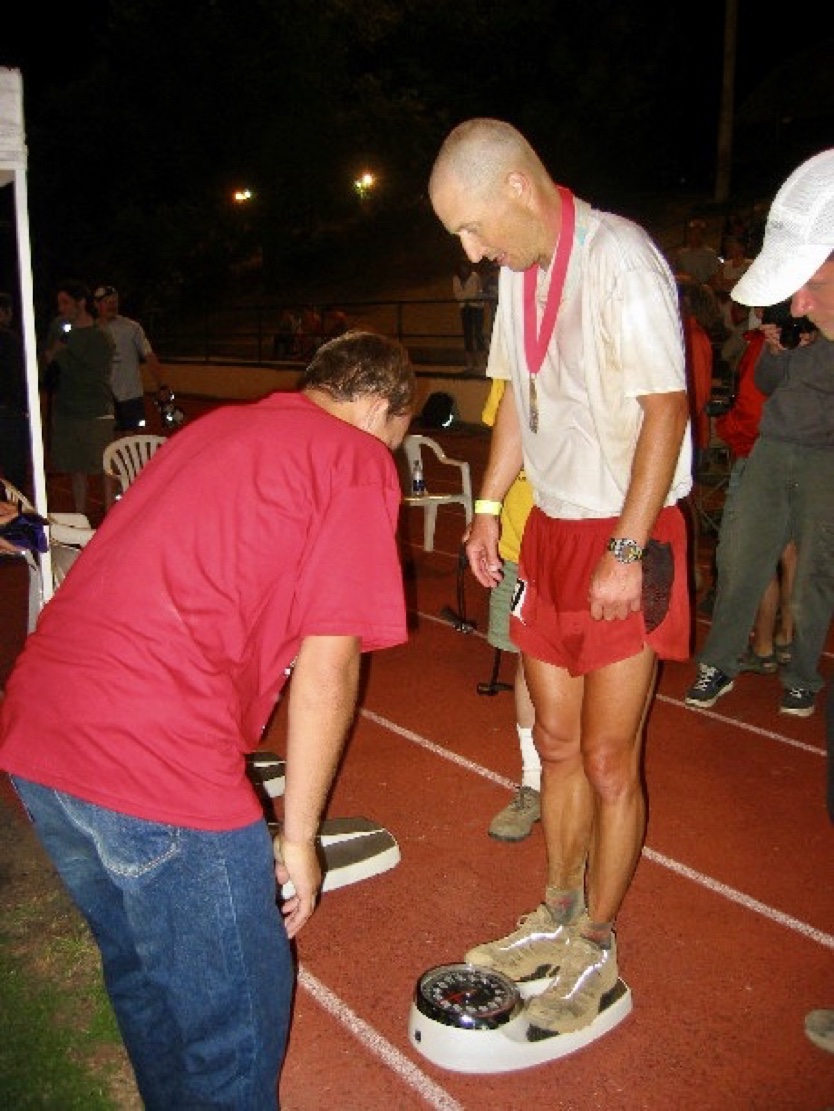
Weighing in at the 2004 Western States 100 finish line. The weigh-in practice is no longer used at the WS 100. Photo courtesy of Craig Thornley.
From Computer Guy to Race Director
Back in the early 2000s, when Thornley became increasingly passionate about training and racing Western States, he was living in Eugene, Oregon, with his wife, Laurie. The couple had married in 1986, and Thornley worked part time as a computer-systems administrator at the University of Oregon, where he had attended undergraduate and grad school. He had studied computer science since high school, partly influenced by his father, who worked as a systems analyst for IBM.
“I didn’t want to work full time, ever, and I thought working in computers would be a good way to make money and not have to work 40 hours a week,” he said unabashedly.
In his spare time, in addition to running, Thornley pursued a serious interest in climbing during summers, and worked as a ski patroller during winters. He built a climbing wall in his garage and accomplished a handful of big-wall climbs including El Capitan in Yosemite National Park.
Twenty years ago, not nearly as many ultramarathons existed, and Thornley and other Oregon ultrarunners generally traveled to Northern California to race. They wanted a tough ultra they could call their own. After Thornley and Curt Ringstad, a runner from Bend, went on a 22-mile run around Waldo Lake in the Willamette National Forest, they got the idea to create a route for what would become the Waldo 100k, which debuted in 2002 with Thornley and Ringstad as co-race directors.
Ringstad, who still lives in Bend, credits Thornley’s organizational skills with getting the race off the ground, and he said Thornley brought safety awareness and protocols learned as a ski patroller to the role of race director.
“He was great to work with because he’d do what needed to be done,” Ringstad said of Thornley. “I would’ve quit after the first three years of Waldo if it weren’t for him setting up the communications system with ham-radio guides. I was convinced we were going to kill somebody” because of the difficulty of the course, but “Craig set up an impeccable communications and medical system.”
Thornley directed Waldo 100k for a decade. “Craig was great to work with,” said 12-time WS 100 finisher and then Oregon ultrarunner Meghan Laws, who in 2011 began assisting Thornley as Waldo 100k co-race director when Ringstad retired from the role. “He assigns jobs to folks he knows he can trust to do a great job, and sets them free to do them, no micromanaging. He’s positive and hard-working, and he instills confidence.”
During this period, around the late 2000s, Thornley became more influential in the sport by starting a blog, ”Conduct the Juices,” which published irreverent commentary about ultrarunning in general and about the Western States 100 in particular.
“’Conduct the Juices’ was incredibly influential in the glory days of the blog,” Jones-Wilkins said, “and Craig and I had a blast using our blogs to poke fun at one another and also to poke the hornets’ nests of the ultrarunning community.”
Given his experience directing the Waldo 100k, and his strong ties to Western States, it’s not surprising Thornley’s name rose to the top of consideration for taking over WS 100’s chief job when then race director Greg Soderlund got ready to retire. But, Thornley himself was surprised.
Thornley recalls his 2011 Western States race—his eighth—revolved around the sudden realization that he should apply for the job, because Soderlund had approached him shortly before the start and told him, “You know, it’s not a done deal who the next race director is.”
“When he told me that, right before the race, it switched my mindset to, ‘Holy cow, could I really be the race director of this event?’ And it freaked me out. I was scared, thinking, Can I do this? This is a huge event; Waldo is tiny compared to Western States,” said Thornley. “I still ran okay, 20:47.”
Taking the Helm of the Race He Loves
When the WS 100 board interviewed Thornley for the race-director position, he told the board what he thought they needed to hear, not necessarily what they wanted to hear. He shared his belief that the race must evolve to stay successful and that it needed greater transparency in its lottery process.
Longtime board member John Trent recalls that Thornley challenged the board members during his interview by expressing that “we were all so locked in our way of thinking —‘The Western States Way’—that we wouldn’t be receptive to new voices or new ideas. I thought at the time, Craig either just completely lost this interview, or he won it. He won it. … His voice and ideas helped lead us down a period of pretty unprecedented success and growth as an organization.”
The board announced in early 2012 that Thornley would succeed Soderlund, and Thornley spent that year mentoring under him and one final winter working ski patrol in Oregon.
Trent added, “Little did I know that when we hired Craig, we’d also get his wife, Laurie, who is one of the smartest, strategic, and most talented events people I’ve ever run across. They are an amazing couple, totally supportive of one another.”
If one were to watch the race unfold administratively, it’s true that you’d see Laurie seemingly everywhere, helping lead the organization from pre-race to post-race.
When he took over the job of race director at the start of 2013, he persuaded the board that the lottery should make crystal clear how each entrant gains entry. Given how coveted each of the 369 Western States entries are, the approximately 105 spots given annually to entrants who can bypass the lottery—the so-called “automatics”—can spark controversy and sour grapes unless everyone knows how and why those spots are allocated, he reasoned.
In earlier years, Thornley recalled, “Someone would show up on the entrants’ list and people would be like, ‘How did that guy get in?’ Now, we denote how everybody got in the race, and that was a huge change that forced the race to really examine those spots because they’re out in the public.” (The automatic entries are spelled out on this page.)
Other big changes also came to pass once Thornley became race director, several involving thorny contemporary issues. The WS 100 became part of the Ultra-Trail World Tour (UTWT); the board released a new drug-testing policy and protocols; the board added a wait list to its lottery, and announced pregnancy-deferral policies to accommodate women who become pregnant before the lottery or after entry in the race; and most recently, in 2019, the board closely studied the science and controversy around transgender athletes and adopted a thoughtful policy for inclusion of transgender runners in the WS 100.
Trent said about Thornley, “When concepts like the UTWT were being hatched, he was one of the first people to truly understand what it could mean. … He’s very strategic as far as taking a ‘high concept’ idea like UTWT and understanding how it might impact an American race like Western States.” As a result, the WS 100 now attracts more international runners.
Meanwhile, with each passing year as race director, Thornley endeavored to put systems and people in place so that race day ran as problem-free as possible, with him delegating authority to positions called “RD2s.”
“Craig has empowered several RD2 roles so that decisions can be made without him being involved in every situation,” said Joe Steinmetz, WS 100’s ham-radio coordinator who oversees the event’s communications. “One thing Craig has done is surround himself with good people who work very well together as a team. It takes a village to make WS 100 a world-class event.”
By 2017, Thornley felt that race-day operations were being managed well enough that he personally could run the race another time, thus spending the Western States weekend as a competitor rather than as the person in charge. He therefore lined up for his ninth, and perhaps most memorable, Western States 100 run.
The Golden Finish
Thornley got to the starting line of the 2017 WS 100 physically exhausted and sleep deprived. He had been working in overdrive with a trail crew to repair the trail all week leading up to race day.
“The snowpack was the problem. It left so many unknowns until the very end,” he recalled. In one area, roads and culverts had been removed that winter to make the area more natural, which caused erosion of the trail, which the crew did not discover until snow melted at the 11th hour. They had to scramble to repair it.
Never before had Thornley run the Western States 100 so slowly and so tired. Never before had he been surrounded by runners finishing closer to 30 hours than 20 hours. So, how did he like it?
“I absolutely loved it! Of course, I’d like to run faster, but I got to see the aid stations—the only way for a race director to see every aid station—and they treated me, a back-of-the-packer, with the same enthusiasm and joy as they did the first runners. That was mind-blowing to me,” he said, his voice conveying pride and admiration for the volunteers.
Thornley, whose previous slowest Western States time had been 22:17, finished that year in 29:11 during the fanfare of the “Golden Hour” when runners push to make the event’s 30-hour cutoff.
Trent fondly recalls the scene as Thornley ran the final mile: “Dozens and dozens of us were all running with him, and I remember looking at him thinking, This is what he’s built this thing into, a community that cares. It wasn’t colorful, it wasn’t ‘Lord Balls,’ it was simply very moving and beautiful to see … the Western States experience, how it’s about community, about the commonality and goodness of our ultra family, and about personal transformation.”
“Craig said later that might’ve been his most important finish ever, because it truly taught him about Western States in its 30-hour entirety,” Trent added. “He was several years into being race director, and there he was, utterly exhausted and humbled, still learning new things about our race. I thought that might’ve been his finest hour.”
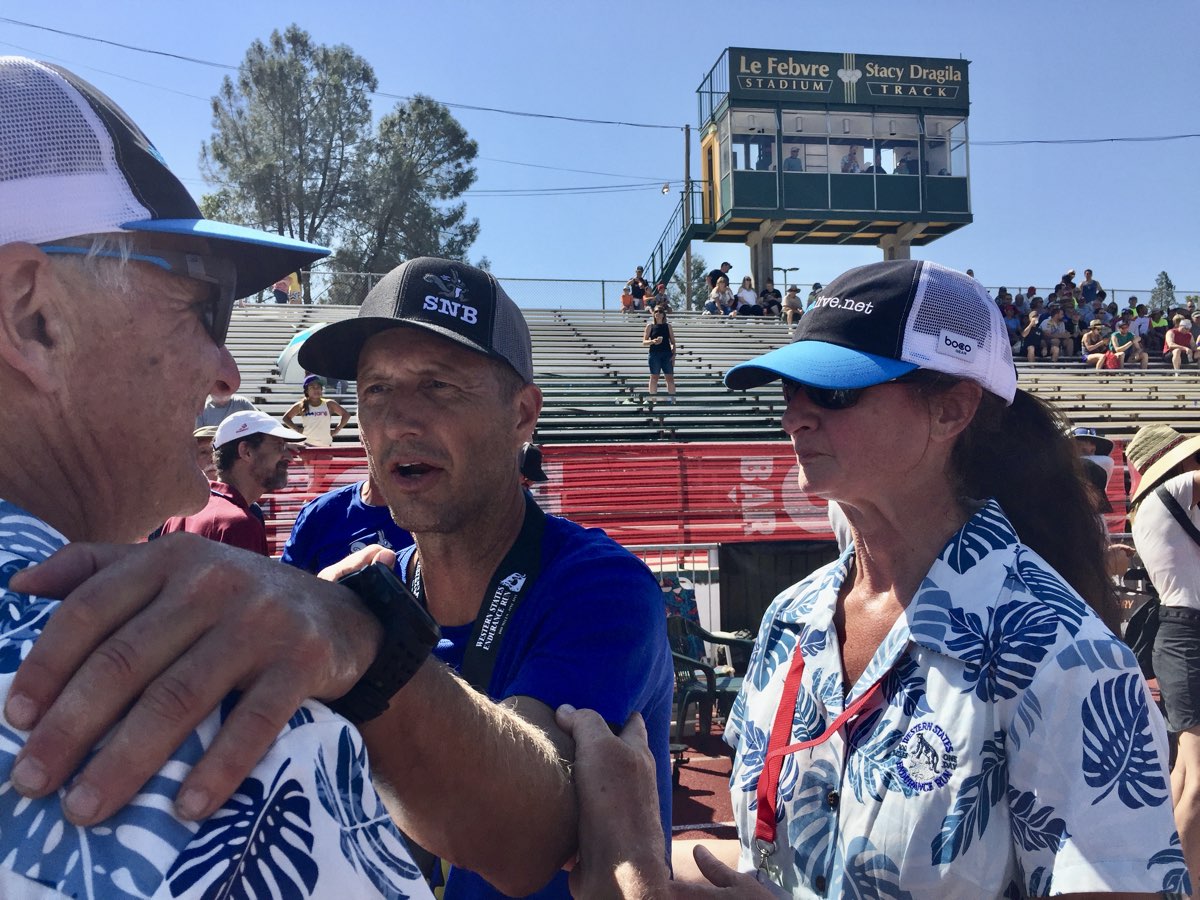
With wife Laurie after finishing the 2017 Western States 100 during the “Golden Hour,” the last hour before the event’s 30-hour cutoff. Photo: iRunFar
Looking Ahead, Not Back
Thornley intends to meet his goal of 10 Western States finishes, but he may wait until he retires as race director to run it the 10th time.
Asked what makes him most nostalgic about the earlier days of the race, when he was in his heyday as a competitor, he said, “I don’t look like back like that; I’m not curmudgeonly. The sport is evolving, and everything that happened in prior years is part of the foundation of where the race is now—all the decisions made, all the people who ran—it’s all part of this huge collection that has made Western States what it is today. We’re going to keep moving forward and continue to make changes to make it better. Hopefully, when I step down, the next race director will continue to take the race into the future.”
Though his departure from the role is not imminent, he is a planner and therefore already thinking ahead to plan for it. Asked how long he’ll stay on the job, he answered at least 10 years—which would mean retirement in 2022—or up to 13, which was the tenure of his predecessor.
“I’ve been thinking a lot about what the race is going to do to replace me,” he said. To that end, he is working with the board to proactively address what they see as the threats to the future of Western States.
“We have to make sure we continue to evolve, and make sure we have a progressive board that doesn’t say, ‘Well, we did it this way in 1984 and were successful.’ I expect we’ll keep evolving,” he said.
One fairly obvious threat is what he calls “the over-subscription problem” caused by the demand that far exceeds the spots available to participate.
In the December of 2019 lottery to choose entrants for the 2020 edition, 6,666 applicants had tickets in the pool, an increase of 14% over the prior year. The odds of getting selected with only a single ticket was a mere 1.2%. Each year an applicant is not chosen, they can accumulate more tickets by re-qualifying and re-entering. Under the current lottery formula, it takes applicants five consecutive years or longer to get their odds of being selected into the double digits, causing compounding frustration for perennial applicants who don’t get chosen.
“We don’t want people to get so frustrated trying to get into the race that they say, ‘Screw this.’” Not only would that hurt the runners, he said, but it also could hurt the event’s sponsorship if the race lost its attractiveness to the larger community of runners.
“You’ll see more lottery changes in the future; it’s inevitable,” he said. Options to address the over-subscription problem include restricting the number of qualifying races, changing qualifying standards, and/or changing the lottery formula. (The option of increasing the number of spots available, from the current 369, is a longshot; one of the event’s public-lands permits historically defines the event’s entrants number, and wilderness advocates likely would push back efforts to raise it.)
Most likely, Thornley said, the board might consider changing the lottery formula to increase the chances of those with multiple tickets being selected. “Now, because of the increase in the number of applicants each year, the system we have in place isn’t substantially increasing the probability of getting in in subsequent years. That has to be addressed. … It’s important for runners to see they have an increased probability of getting in each successive year.”
The final big threat Thornley mentions involves the trail itself. The event has a tenuous agreement with the Forest Service to access the Granite Chief Wilderness Area, in between miles three and 10, and the board is working with a local congressperson to strengthen its long-term right to continue running the event along that part of the trail.
And what about the newest threat of the coronavirus? Thornley says it’s too soon to tell, and he and the board are consulting with a working group comprised of several race directors studying how to lower the risk of the virus while putting on ultras. “Are we going to have aid stations like we normally do with buffets? I don’t know. It’s a year away.”
Thornley doesn’t seem to mind tackling these problems. “I’ve always enjoyed working with organizations and effecting change, especially something as big as Western States. Trying to get the ship to move in a different direction and get everyone to row in that direction is really satisfying.”
But the best part of the job, he says—the part that makes him most excited for the 2021 edition of Western States—is watching runners make the journey he himself has made nine times, from the starting line to the finish.
“I get to watch runners in their journey to get a spot on the starting line—which is a big multiyear effort for many—and then get to see them running on race day and getting to the finish line,” he said. “I like to watch the myriad emotional responses people have, and I try to be there at the finish line as many hours as I can. Those are the best parts of the job.”
Call for Comments
- Leave a comment to share a story about running, adventuring, or racing with Craig Thornley.
- Have you run the Waldo 100k or the Western States 100 while Craig was race director? Share your story about him at the helm of either race in the comments section!
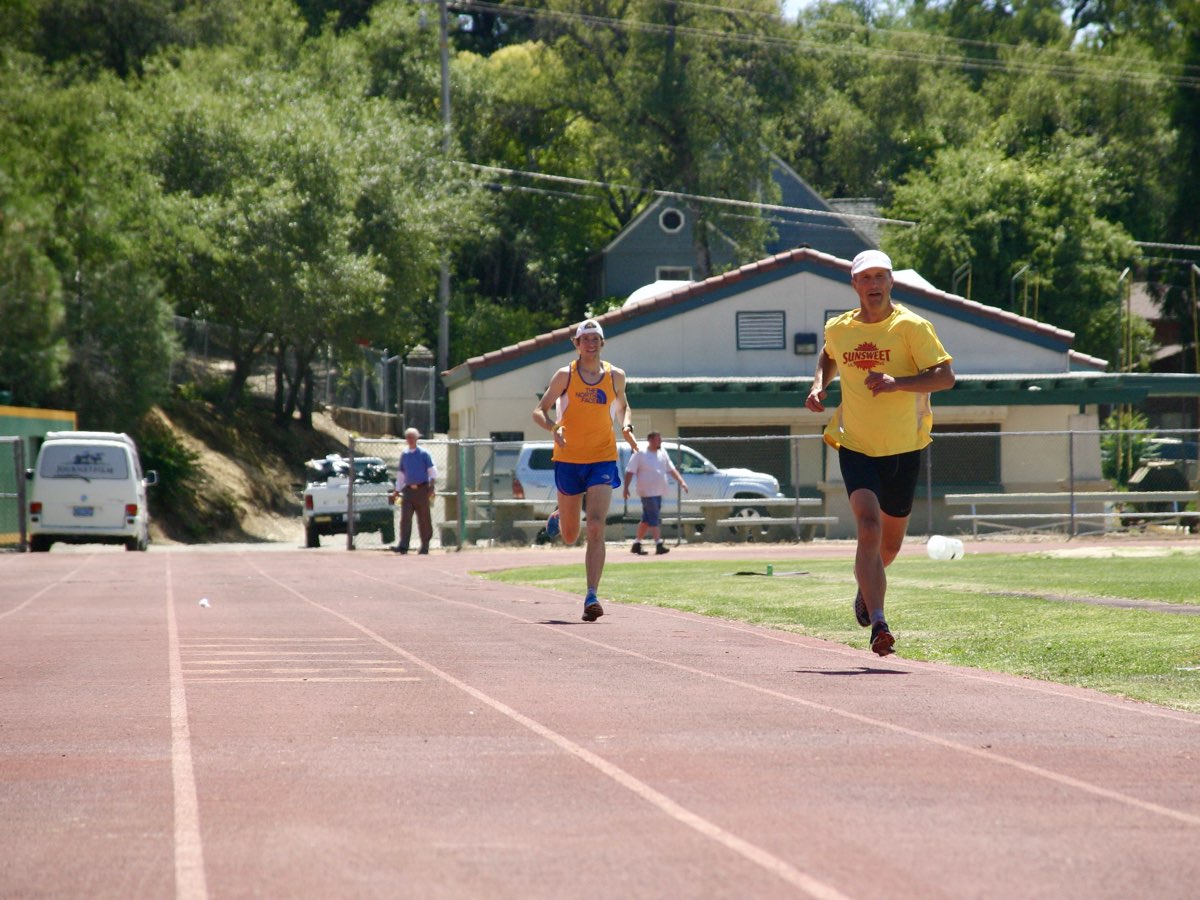
Racing Michael Wardian in a mile race the day after the 2012 Western States 100 on the Placer High School track where the 100-mile event finishes. Incredibly, Craig had just spent the preceding days co-directing the WS 100 with outgoing race director Greg Soderlund and Mike had run the race himself! Photo: iRunFar
